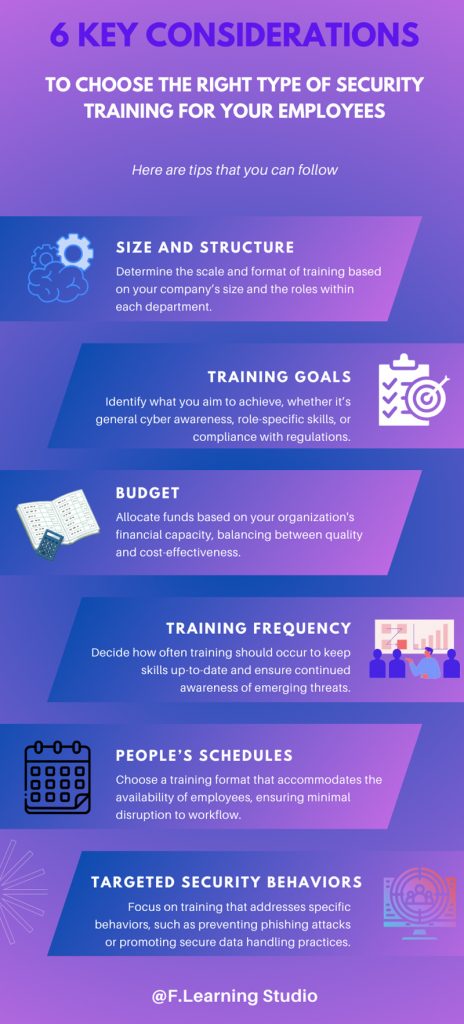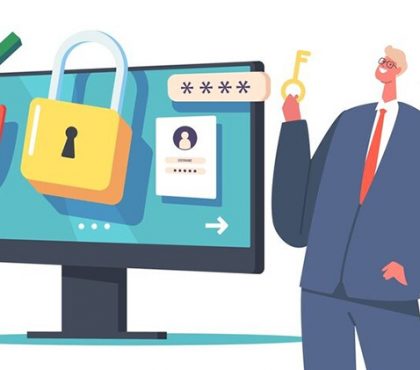In 2025, understanding the types of cybersecurity training is essential for organizations to safeguard their digital assets. This article highlights 8 key types of cyber security training including Classroom-Based Training, Web-Based Training, Simulated Phishing & other Social Engineering Attacks, Security Awareness Computer-Based Training, and more.
Each is designed to tackle common challenges such as employee knowledge gaps, phishing risks, and and lack of awareness. Read on to find the ideal training solutions to build a more secure, cyber-aware team!
- 6 Reason-why Corporate Should Implement Cyber Security Training
- 8 Main Cyber Security Training Types to Watch in 2025
- 6 Key Considerations to Choose the Right Type of Security Training for Your Employees
- TOP 5 Essential Cyber Security Certifications to Enhance Your Career
- 6 Exciting Trends in Cybersecurity Training Programs to Watch
- Collaborate with F.Learning Studio – A Leading Provider for Web-Based Cyber Security Training
- Final Thoughts
6 Reason-why Corporate Should Implement Cyber Security Training
In today’s digital landscape, businesses face an increasing number of cyberattacks that threaten their operations, data, and reputation. Implementing cyber security training is no longer optional – it’s essential for safeguarding company assets and building a resilient workforce.
- Protects Sensitive Data: Reduces the risk of data breaches, safeguarding confidential company and customer information.
- Enhances Employee Awareness: Empowers staff to recognize and prevent potential cyber threats like phishing and malware.
- Minimizes Financial Loss: Prevents costly cyber attacks that could lead to financial losses and business interruptions.
- Strengthens Compliance: Ensures adherence to industry standards and legal requirements, avoiding regulatory fines.
- Builds Customer Trust: Demonstrates a commitment to cybersecurity, enhancing customer confidence and loyalty.
- Mitigates Internal Threats: Educates employees on secure practices, reducing accidental or intentional internal threats.

8 Main Cyber Security Training Types to Watch in 2025
Cybersecurity training programs come in various formats to address different needs and approaches. They can be categorized into 2 main types: those that focus on content or purpose and those structured by delivery method.
Understanding these distinctions can help companies choose the most effective training type to bolster security awareness and resilience against cyber threats, including common risks like phishing attacks.
Based on Content or Purpose Focus:
| Training Type | Description | Key Benefits | Pros & Cons |
| Awareness Program | Aims to increase general awareness of cybersecurity threats and best practices among employees, helping them recognize issues like phishing attacks. | Reduces risk by educating employees on avoiding common cyber risks | – Pros: Broad accessibility, and quick implementation. – Cons: Limited depth, may not cover advanced threats. |
| Role-Based Training | Tailored to specific roles within the company, focusing on the security skills relevant to each job to counter specific cyber threats. | Ensures employees understand risks specific to their job function | – Pros: Highly relevant, targeted skills. – Cons: Higher resource investment, may miss broader threats. |
| Compliance Training | Focuses on industry regulations and compliance standards to help meet legal and regulatory needs. | Helps avoid legal issues and ensures adherence to industry standards | – Pros: Legal protection, meets compliance. – Cons: Limited scope, often not updated frequently. |
| Advanced Technical Training | Provides in-depth technical skills to IT and security teams for threat detection and response. | Builds a skilled response team for complex threats | – Pros: Detailed, advanced skills. – Cons: Expensive, time-intensive, limited to specific employee groups. |
| Phishing Simulation Training | Simulates phishing attacks to train employees on identifying phishing emails and responding appropriately. | Improves employee vigilance and reduces the likelihood of successful phishing attacks. | – Pros: Real-world practice, measurable outcomes. – Cons: May require regular updates to remain effective. |
| Executive Cybersecurity Training | Tailored for leaders and C-level executives, focusing on strategic decision-making, risk management, and understanding high-level cybersecurity threats. | Equips executives with knowledge to make informed cybersecurity decisions and recognize key threats. | – Pros: Informed leadership, enhanced strategic response. – Cons: Often time-consuming, may be costly. |
Based on the Delivery Method:
| Training Type | Description | Key Benefits | Pros & Cons |
| Classroom-Based Training | In-person sessions led by cybersecurity experts offer interactive and hands-on learning experiences. | Provides direct interaction with trainers and immediate feedback. | – Pros: Engaging, allows for Q&A, and encourages group discussion. – Cons: Limited to physical locations, can be time-consuming and costly. |
| Web-Based Training (eLearning) | Online courses that employees can complete at their own pace, using videos, quizzes, and other multimedia. | Flexible and accessible, allowing for organization-wide scalability. | – Pros: Convenient, cost-effective, scalable, and accessible for remote workers. Interactive training elements keep learners engaged. Enables personalized learning experiences. – Cons: Can be difficult to track engagement without live facilitation, and learners may face distractions while studying independently. |
| Simulated Phishing & other Social Engineering Attacks | Realistic simulations (e.g., phishing emails) that test and enhance employees’ responses to cyber threats. | Reinforces practical knowledge and lowers the risk of falling for real-world attacks. | – Pros: Hands-on experience, effective for identifying vulnerabilities. – Cons: May need specialized software, which could cause stress if not managed carefully. |
| Security Awareness Computer-Based Training | Digital modules covering cybersecurity basics, like password safety, malware, and data protection practices. | Instills a culture of security awareness and is suitable for all staff levels. | – Pros: Scalable, easy to update, ideal for general employees. – Cons: Limited personalization, may lack depth for advanced users. |
6 Key Considerations to Choose the Right Type of Security Training for Your Employees
Choosing the best security training programs for your workforce requires careful consideration of several factors. By aligning training with your organization’s unique needs, you can enhance employee readiness and resilience against cyber threats.
Effective Approaches for Implementing Cybersecurity Training Programs
| No. | Key Consideration | How to Apply |
| 1 | Size and Structure | Conduct a training needs assessment to identify department-specific requirements and role-based training needs. For larger organizations, customize training for different teams or departments. |
| 2 | Budget | Prioritize high-impact training, such as phishing simulations and compliance programs, to get the best value for money. Compare different vendors to find cost-effective solutions that align with your budget. |
| 3 | People’s Schedules | Choose flexible, online, or self-paced training options to accommodate different work shifts and schedules, minimizing disruption to daily tasks. |
| 4 | Training Goals | Align your training program with clear objectives, whether it’s for broad security awareness, regulatory compliance, or targeted skill development for specific roles. |
| 5 | Training Frequency | Decide on an ongoing training schedule (e.g., quarterly or bi-annually) to keep employees updated on new threats and refresh knowledge to maintain a high level of awareness. |
| 6 | Targeted Security Behaviors | Identify specific behaviors to focus on, such as securing sensitive data, avoiding phishing attempts, or maintaining password hygiene, and customize your training to target these areas. |
TOP 5 Essential Cyber Security Certifications to Enhance Your Career
These certifications equip you with critical skills and knowledge to protect against evolving cyber threats and meet the growing demand for security professionals.
| Certification | Description | Ideal Candidates | Key Benefit |
| Certified Information Systems Security Professional (CISSP) | Recognized globally, this certification validates expertise in designing and managing cybersecurity programs. | Experienced security professionals | Enhances career prospects and demonstrates deep knowledge. |
| Certified Ethical Hacker (CEH) | Focuses on identifying vulnerabilities and weaknesses in systems, and teaching ethical hacking techniques. | IT professionals and penetration testers | Develops skills for proactive security measures. |
| CompTIA Security+ | An entry-level certification covering essential security concepts, risks, and vulnerabilities. | Beginners and IT support staff | Establishes foundational knowledge in cybersecurity. |
| Certified Information Security Manager (CISM) | Focuses on management and governance of information security, ideal for managerial roles. | Security managers and consultants | Enhances leadership skills in cybersecurity management. |
| Certified Information Systems Auditor (CISA) | Emphasizes audit, control, and security of information systems, relevant for auditing professionals. | IT auditors and compliance officers | Validates skills in assessing and managing IT risks. |
6 Exciting Trends in Cybersecurity Training Programs to Watch
The field of cybersecurity training is evolving rapidly, adapting to new technologies and the constantly changing landscape of cyber threats. Here are 6 key trends shaping the future of cybersecurity training programs, aimed at reinforcing essential cybersecurity practices:
1. Gamified Learning
Many cybersecurity training programs are incorporating gamification to engage employees more effectively. By using game elements such as points, rewards, and interactive challenges, gamified learning makes complex topics more accessible and enjoyable.
Gamified learning fits well into web-based training (eLearning) or simulated phishing and social engineering attacks, offering interactive modules that increase engagement and improve retention. Programs like phishing simulations in gamified formats can also reinforce real-world scenarios, making the learning experience not only fun but also highly practical.
At F.Learning Studio, we specialize in creating interactive elements and gamified cybersecurity training solutions tailored to your company’s specific needs.
Ready to Level Up Your Cybersecurity Training?
Discover Custom Gamified Solutions with F.Learning Studio Today!
2. Real-World Simulations
Hands-on training that simulates real-world cyber threats is becoming more popular. By mimicking actual cyberattack scenarios (such as phishing, ransomware, or data breaches), employees can practice their responses in a controlled environment.
Real-world simulations work effectively with classroom-based training or web-based training and can be adapted to role-based training for specific functions like IT security teams. These simulations build practical skills and offer real-time feedback on employee performance.

3. AI-Powered Adaptive Learning
Artificial Intelligence (AI) is revolutionizing cybersecurity training by personalizing the learning experience. AI-powered platforms adapt content based on an individual’s progress and comprehension, allowing employees to learn at their own pace.
This is particularly useful for web-based training where employees can take courses tailored to their level of knowledge. For advanced learners, AI-driven programs can offer more in-depth training, while beginners can focus on fundamental concepts, making the training scalable and personalized.
4. Microlearning Modules
Involves short, focused training sessions that cover specific cybersecurity topics in a digestible format. These bite-sized lessons fit into busy schedules, enabling employees to learn at their convenience. This type of training is ideal for web-based training and can be integrated into security awareness computer-based training to deliver quick, targeted lessons on key cybersecurity practices, like password security or recognizing phishing emails.
5. Focus on Threat Intelligence
As cyber threats become more sophisticated, there’s a growing focus on threat intelligence in training programs. Employees are taught how to analyze emerging threats, track cyber trends, and proactively defend against potential attacks.
This trend is especially relevant in role-based training for IT and security teams, ensuring they are equipped with the skills to recognize and respond to advanced threats. It can also be integrated into compliance training to help employees stay updated on the latest security regulations and best practices.
6. Compliance-Centric Training
As the regulatory landscape evolves, compliance with data protection laws has become a top priority. Many cybersecurity training programs are now focusing on the legal and regulatory aspects of cybersecurity, ensuring employees understand how to handle sensitive data and avoid breaches that could result in legal consequences.
Compliance training is essential for all employees, particularly those handling sensitive information or working in regulated industries. It’s often delivered via web-based training or classroom-based training, with modules dedicated to specific regulatory frameworks like GDPR, HIPAA, or CCPA.
Investing in cybersecurity training as a core business strategy is essential for organizations facing increasingly sophisticated cyber threats. The trends discussed – such as gamified learning and real-world simulations – highlight the need for modern training methods that enhance employee preparedness and foster a proactive security culture. By equipping employees with the knowledge and skills to identify and respond to potential security breaches, organizations can significantly reduce the likelihood of costly incidents.

Additionally, a strong focus on cybersecurity training fosters a culture of awareness and responsibility among staff, enhancing overall resilience against cyber attacks. This proactive approach not only helps in compliance with regulatory requirements but also builds customer trust, positioning the organization as a reliable partner in today’s digital landscape.

Collaborate with F.Learning Studio – A Leading Provider for Web-Based Cyber Security Training
1. Tailored Web-Based Training Solutions for Cyber Security
F.Learning Studio specializes in creating customized animated training programs that align with your organization’s goals and the unique challenges it faces. Our tailored solutions ensure that employees receive relevant and impactful training that directly addresses the cyber threats pertinent to your industry.
We work closely with your team to assess your specific needs, developing training content that resonates with your workforce while addressing the latest security risks.
2. Engaging Online Learning Experiences for Cyber Security Awareness
We understand that effective training goes beyond traditional methods; engagement is key to retention. Our interactive and gamified learning modules transform standard training into dynamic experiences, enhancing knowledge retention and promoting proactive cybersecurity practices among staff. Through simulations, quizzes, and real-world scenarios, employees not only learn about security measures but also practice applying them in realistic situations, thereby reinforcing their skills.
Empower Your Team, Secure Your Future!
Transform Cybersecurity Training into Engaging Experiences with F.Learning Studio Today!
3. Expert Insights and Support for Your eLearning Cyber Security Journey
F.Learning Studio provides ongoing support and insights throughout your eLearning journey. Our team stays up-to-date with the latest trends and threats in cybersecurity, ensuring your training programs remain current and effective in combating evolving cyber risks. We offer continuous assessment and feedback with a streamlined process to help your organization adapt its training strategies and ensure that employees are well-prepared to respond to potential security incidents.
Final Thoughts
As cyber threats continue to evolve, understanding the various types of cybersecurity training available is essential for organizations committed to safeguarding their data and assets. By incorporating methods like gamified learning and real-world simulations, organizations can ensure their teams are equipped to respond swiftly to potential security incidents.

If your organization is ready to take the next step in enhancing its cybersecurity posture, F.Learning Studio is here to help. With our expertise and dedication to effective learning, we can assist you in building a comprehensive cybersecurity training program that empowers your workforce and fortifies your defenses against evolving cyber threats.
Ready to bring your cybersecurity training to life? Let’s connect! We’d love to help you tackle those training challenges and create an engaging experience for your team.
- Email: [email protected]
- Fanpage: https://www.facebook.com/f.learningstudio
- Website: https://flearningstudio.com/
- LinkedIn: https://www.linkedin.com/company/f-learning-studio/

Sean Bui, the founder and creative director of F.Learning Studio, is a respected leader in the e-learning and multimedia production industry. With over 10 years of experience, he has dedicated his career to helping organizations create engaging and impactful learning experiences.
Under his leadership, F.Learning Studio has grown into a trusted partner for organizations in the education, healthcare, and corporate training sectors, producing over 2,000 minutes of educational animation.










